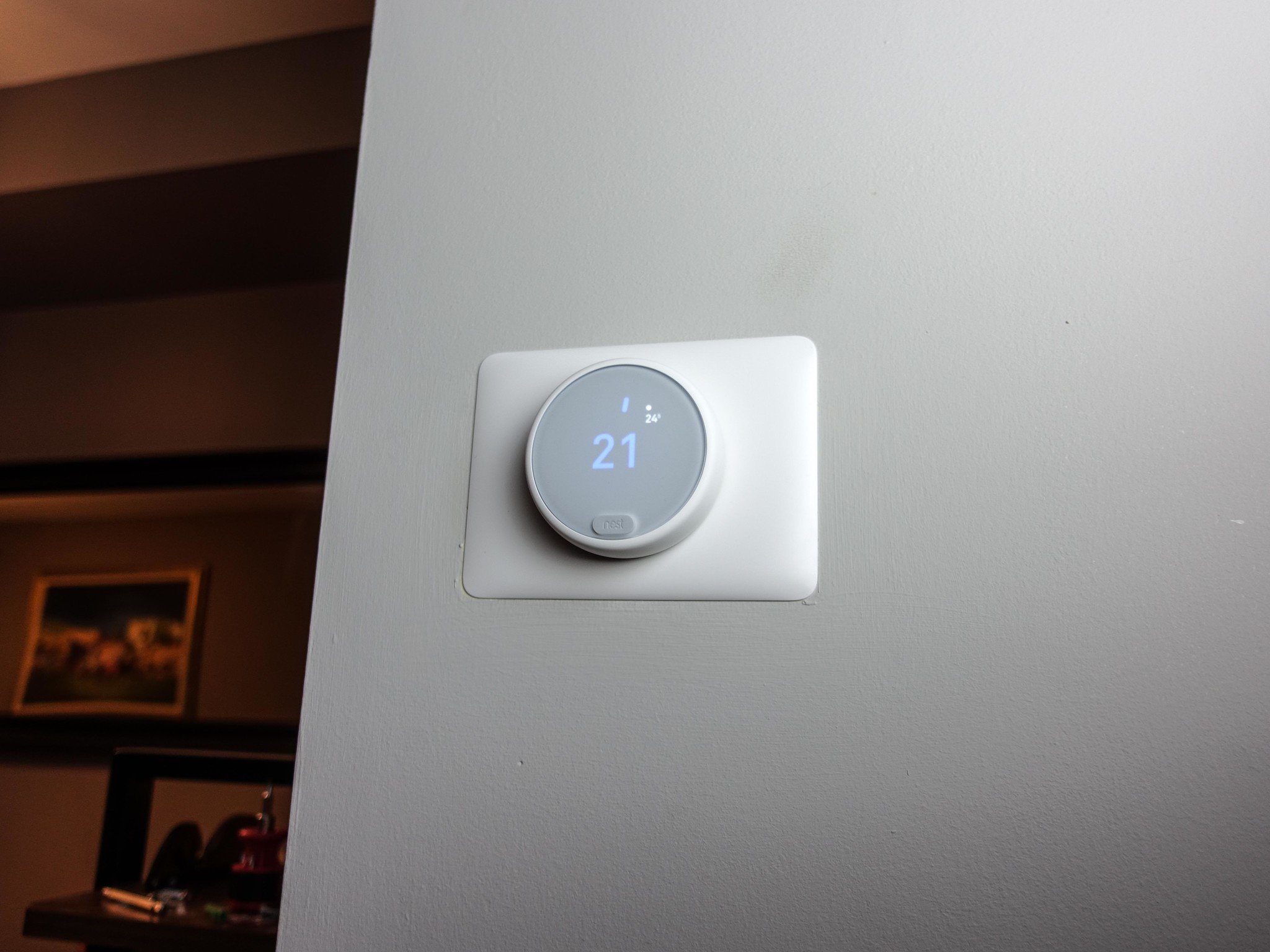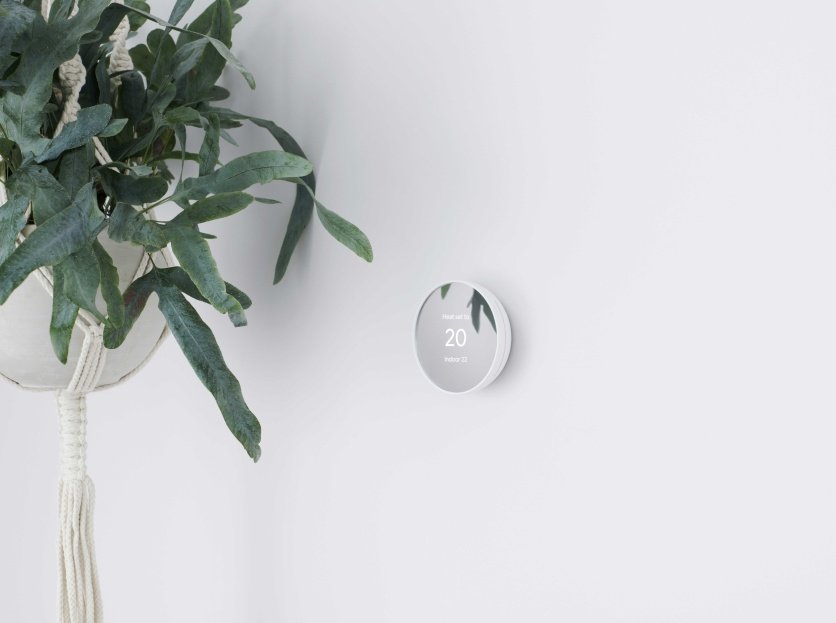Still our favorite
Nest Thermostat E
Pros
- Learns and adjusts schedule automatically
- More pixels per inch in LCD display
- Ships with trim plate
- Saves energy when you're away from home
- HVAC monitoring
- Works with remote sensors
Cons
- Only comes in white
- Not widely available
- Must set up in Nest app
The Nest Thermostat E is one of the smartest thermostats you can buy, with the ability to track your temperature changes and build you a customized, automated heating schedule that will save you energy. That said, it's a relatively old device with an average LCD display.
Colorful and revitalized
Nest Thermostat
Pros
- Better color options
- Larger mirrored lens with IPS
- Soli motion tracking and geofencing
- Savings Finder and HVAC monitoring
Cons
- No remote sensors
- No schedule learning capabilities
- Trim plate sold separately
- Low resolution display
The new Nest Thermostat is a simpler device that puts all of its smarts in the Google Home app and requires you to build and tweak your own energy-saving schedule. Its Soli radar and geotracking will sense when you leave home and turn off your HVAC energy usage.
We're weighing the latest Nest Thermostat vs. Nest Thermostat E, two relatively affordable smart thermostats that serve as budget options compared to the premium Nest Learning Thermostat. Google has stopped selling the Nest Thermostat E except to professional installers, but a few retailers still have stock (for now), and it has been our top-ranked thermostat for years. So should you snatch up the older E model while you still can, or go with the latest Nest Thermostat? There's a case to be made for either device.
Nest Thermostat versus Nest Thermostat E: Not much has changed
The new Nest Thermostat may have a shiny new mirrored lens, but in most other areas you could call it a mirror image of the Nest Thermostat E. Both lack many of the perks you get with the Nest Learning Thermostat, and some of the improvements of the Nest Thermostat are app-based, meaning current Nest Thermostat E owners can benefit from them as well.
For starters, both thermostats work with 85% of heating, ventilation, and air conditioning (HVAC) systems. Neither requires a C wire to work, and both will be compatible (or incompatible) with the same systems. However, all Nest thermostats sometimes run into problems when installed without a C wire, so in either case you may end up wanting to manually install a C wire to give them a more consistent power source.
Once installed and wired into your HVAC system, Google will monitor your HVAC performance, measuring how long it takes for the system to heat or cool your home to the target temperature. If it measures a drop in performance, you'll receive a notification warning you that it may need fixing. While this is a new feature for the Nest Thermostat, Google has also added monitoring to its older thermostats too.
Both thermostats offer HVAC monitoring, geofencing, smart home compatibility, IFTTT support, and compatibility with the same heating systems.
While the two thermostats' displays are fairly different, one similarity we'll highlight here is that both are fairly low-resolution: the Nest Thermostat E is 320x320 pixels while the new Nest Thermostat is 240x320 pixels. Neither supports the Farsight technology found on the Learning Thermostat that makes the temperature reading larger when you're standing further away. Whichever you choose, you may need to stand fairly close to it to see the temperature clearly.
The Nest Thermostat E has some smarter scheduling options than the Nest Thermostat (more on that below), but both support geofencing and proximity sensing, so it knows when you've left home and will automatically turn down the heat or air to save energy while you're out. Moreover, through the Google Home app, you can manually schedule temperature changes throughout the day, and you'll receive suggestions from Google's Savings Finder on ways you can optimize your schedule for energy savings.
Want the convenience of changing the temperature without having to get up? The Nest Thermostat and Thermostat E can connect to your smart speaker, so you can command Alexa or Google Assistant to change the temperature from the couch.
Nest Thermostat versus Nest Thermostat E: Mostly incremental changes
Now that we've established how similar these two smart thermostats are, let's dive into the ways that Google has updated its newest device — including some changes that make it less advanced than the Nest Thermostat E. For starters, check out the side-by-side specs.
| Nest Thermostat | Nest Thermostat E | |
|---|---|---|
| Price | $118 | $169 |
| Dimensions | 3.3 x 1.1 inches | 3.19 x 1.14 inches |
| Colors | Snow, Sand, Fog, Charcoal | White |
| Trim Plate | Sold separately | Included with purchase (Polycarbonate) |
| Display | 2.4-inch IPS LCD with mirrored lens 240x320 pixels |
1.76-inch frosted LCD 320x320 pixels, 182 ppi |
| Soli | Yes | No |
| Energy Star Certified | Yes | Yes |
| Built-in sensors | Motion Temperature Humidity Capacitive touch Ambient light |
Temperature Humidity Proximity Occupancy Ambient light |
| Remote sensors | No | Yes |
| Manual temperature changes | Touch strip on side | Physical turn-dial |
| Automatic scheduling | No | Yes |
| App connectivity | Google Home | Nest for setup; Nest or Google Home for controls |
| Voice assistants | Alexa & Google Assistant | Alexa & Google Assistant |
| Power | Various HVAC system wires, 2 AAA battery backup | Various HVAC system wires; rechargeable lithium ion battery |
| HVAC Compatibility | 85% of systems | 85% of systems |
| HVAC problem monitoring | Yes | Yes |
| Wi-Fi | 802.11b/g/n 2.4 GHz, 802.11a/n 5 GHz Wi-Fi 802.15.4 Bluetooth LE |
802.11 a/b/g/n 2.4GHz / 5GHz 802.15.4 Bluetooth LE |
| Turns down heat when away from home | Yes | Yes |
The Thermostat E has a physical polycarbonate dial that can be turned to change the temperature, while the Nest Thermostat has a touch strip on its side that you must either swipe up and down on or tap and hold on the top or bottom to change the temperature.
The Nest Thermostat wins the Nest beauty contest, though neither thermostat's display is that impressive.
If this comparison is a beauty contest, then the new Nest Thermostat would win. The lack of the turn dial gives the newer model a thinner appearance along the edge, so the display appears to fill more of its volume. And while the Thermostat E only comes in one color (white), the newer model has four color options that'll make it more likely to blend in or pop out against your walls.
As for the displays themselves, the Nest Thermostat E is somewhat notorious for being difficult to read thanks to a low-resolution, glazed screen. The new Nest Thermostat doesn't up the resolution but makes a shift to a new IPS LCD display that will have better side viewing angles, and uses a mirrored lens that gives it a reflective sheen whenever the display isn't active.
To track when to activate the display, the new Nest Thermostat uses Soli radar, the same motion-tracking tech used in the latest Google Pixel phones. The Nest Thermosat E has its own proximity and occupancy sensors to determine when to activate, but we can't say for certain if Soli or these unnamed sensors are better than the other. Theoretically, Soli may be more accurate since it's newer.
Only the Nest Thermostat E will build a heating and cooling schedule for you.
Google has migrated its new thermostat interface away from the Nest app to Google Home, so the new Nest Thermostat is only compatible with the Home app. The Nest Thermostat E can only be set up with the Nest app, but from there you can choose between the Nest app or the Home app for scheduling and controls.
The most important difference between the two is that the Nest Thermostat E, like the Nest Learning Thermostat, tracks your energy usage and changes before automatically generating a personalized temperature schedule for your home. With the Nest Thermostat 2020, you'll have to manually program a schedule before Google can start sending you optional savings tweaks.
Finally, the Nest Thermostat E works with remote sensors that allow you to measure specific temperatures throughout your home. If you're willing to pay extra for them, these sensors are useful to monitor larger homes where the temperature varies from room to room. Unfortunately, the new Nest Thermostat isn't compatible with them, making it a better fit for smaller homes or apartments.
Nest Thermostat versus Nest Thermostat E: Don't upgrade, but consider buying new
If you already own the Nest Thermostat E, there really isn't any case to be made that you should replace it with the new Nest Thermostat. There just aren't enough differences between them to make it worth uninstalling and reinstalling a new device just for the sake of a more colorful display.
The Nest Thermostat is a worthy alternative if the Thermostat E goes out of stock.
Shoppers looking for a new device have a tougher decision. Both thermostats are fairly similar in price and features, and will give you the same energy savings in the long run. The Nest Thermostat 2020 will look prettier on your wall and has better Google Home app support, but the Nest Thermostat E makes the initial post-installation period easy by building a schedule for you. Ultimately, we don't think either purchase is the wrong choice, and if the Thermostat E is no longer in stock, the new Nest Thermostat is a worthy alternative.
As a sidenote, we'll also point out that the Nest Learning Thermostat is also worth a look if you can afford it. Check our Nest Learning Thermostat versus Nest Thermostat E and Nest Learning Thermostat versus new Nest Thermostat breakdowns for more information on the third smart thermostat in this talented gadget family.
Still our favorite
Nest Thermostat E
Learning lite
The Nest Thermostat E is the only budget thermostat that mimics the Learning Thermostat's automated scheduling tech, helping to easily reduce your electric bill. It's one of the best smart thermostats you can buy.
Colorful and revitalized
Google Nest Thermostat
Soli sensing
From $118 at Amazon $130 at Best Buy $130 at B&H
Built to work with your Google Home app and smart speaker, the Nest Thermostat 2020 trusts you to figure out your energy saving schedule for yourself, and will look much snazzier on your wall.




0 Response to "You Can See More: Not-so different Nest Thermostat & Thermostat E are both solid budget buys"
Post a Comment